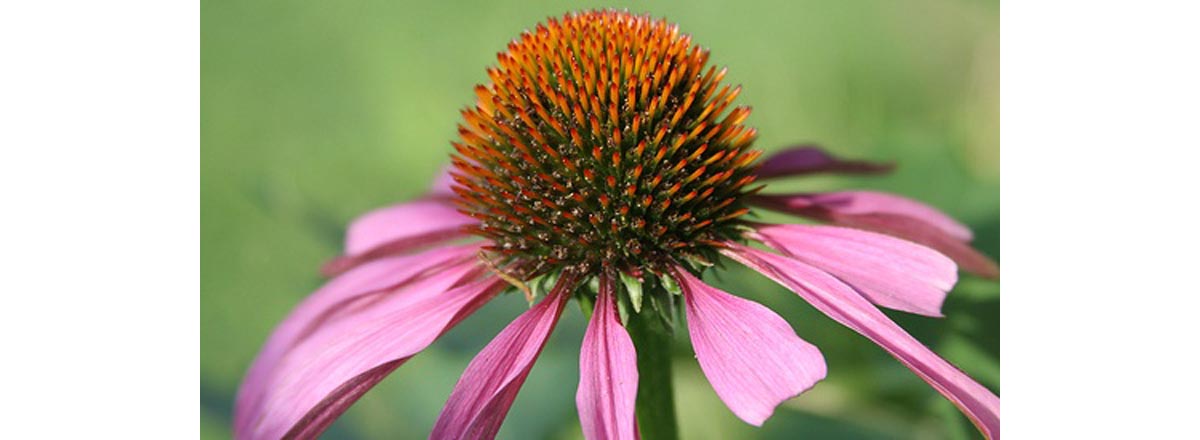Table of Contents
2. Echinacea
Known as one of the most powerful herbs, Echinacea has been used for a long time to strengthen the immune system. It has been used to treat open wounds, syphilitic lesions, cellulitis and cases of blood poisoning.

However, it is most well-known for its efficacy against Staphylococcus aureus, the bacteria which causes the multi-drug resistant infection. Apart from strengthening the immune system, Echinacea is said to possess analgesic and anti-inflammatory properties. It also exerts some degree of antioxidant effect. It has been used to treat ear infections, sinusitis, vaginal yeast, hay fever and even urinary tract infection.
It is believed that Echinacea is also effective in preventing the development of common cold.
People who drink at least five cups of Echinacea tea for four to five days recover faster from the symptoms of common cold.
3. Colloidal Silver
Colloidal silver is again a naturally occurring substance with immense germicidal and antibacterial properties. People have found it to be effective in the treatment of multi-drug resistant Staph. aureus infection (MRSA), open wounds, and multiple viral and fungal infections.
4. Manuka honey
This tasty honey, obtained from Australia and New Zealand, is said to possess potent anti-bacterial properties. It is widely used as a topical application for treating many different types of pathogens including MRSA and necrotizing bacteria. Moreover, no resistance has been seen to develop against manuka honey on its subsequent application.
5. Onion
Rich in its sulfur content, onion is said to have potent anti-bacterial and diuretic properties. It has some degree of anti-inflammatory action as well, and is believed to improve blood circulation. Some people are convinced that onion is also useful against roundworm infestation. It is also effective in preventing episodes of common cold. Onion extract is used as an expectorant in patients suffering from bad coughs.
6. Neem
Neem extract has been found to exert a synergistic and complementary action to prescription antibiotics in the treatment of multi-drug resistant bacterial infections. A research published in a reputed journal has shown that when used with conventional antibiotics, neem is effective in treating Staph. aureus infection.
7. Green Tea
Research has shown that green tea contains gallic acid, a polyphenol, which acts synergistically with other antibiotics in treating Streptococcus as well as E-coli infections. Green tea is rich in antioxidants and helps in boosting body’s immunity against common infections.
8. Pau d’ Arco
Pau d’ Arco is herb found in South America. It contains lapachol, which is effective in treating bacterial, viral and fungal infections. It strengthens the immune system of the body and is believed to have cancer-fighting properties.
9. Oregano Oil
Oregano oil is a potent natural remedy known for its various health benefits, particularly its antimicrobial properties. It is derived from the leaves of the oregano plant (Origanum vulgare) through a steam distillation process. The primary active compounds responsible for its therapeutic effects are carvacrol and thymol, both of which have strong antibacterial, antifungal, and antiviral properties.
10. Turmeric
Turmeric is a bright yellow spice commonly used in cooking, particularly in Indian and Asian cuisines. It comes from the root of the Curcuma longa plant and contains an active compound called curcumin, which is responsible for many of its health benefits. Turmeric has been used for centuries in traditional medicine and is well-known for its anti-inflammatory, antioxidant, and antimicrobial properties.
11. Ginger
Ginger is a popular spice and medicinal herb derived from the root of the Zingiber officinale plant. It has a long history of use in traditional medicine and culinary applications, particularly in Asian and Indian cuisines. Ginger contains several bioactive compounds, including gingerol, which is responsible for its many health benefits.
12. Grapefruit Seed Extract
Grapefruit seed extract is a natural substance derived from the seeds, pulp, and white membranes of grapefruits. It is known for its potential antimicrobial properties and has been used for various health purposes. The active compounds in grapefruit seed extract include flavonoids, polyphenols, and vitamin C, which contribute to its potential health benefits.
All these natural substances are potent in fighting diseases and do not produce side-effects. That is why, naturalists recommend that they should be the first line of treatment against common infections and conventional antibiotics should be reserved only for serious infections.
- “Echinacea”, by Steven D. Ehrlich, published by University of Maryland Medical Center, reviewed last on January 12, 2011, accessed on November 24, 2012.
- “MRSA: Natural Methods for Prevention”, by Gene Bruno, in Smart Supplementation, accessed on November 24, 2012.
- Photo courtesy of buzzhoffman on Flickr: www.flickr.com/photos/buzzhoffman/4498606939
- Photo courtesy of adulau on Flickr: www.flickr.com/photos/adulau/982277999

